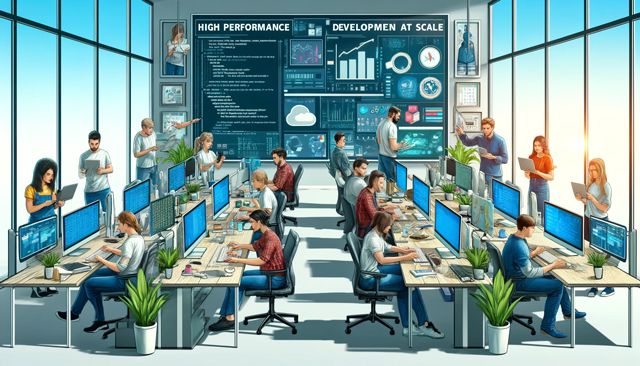High-Performance Software Teams: A Contemporary Approach
In a world where software development drives innovation, we’ve mastered automating code quality, yet the quality of our collaboration often remains overlooked. At PixelMixer, we’ve reimagined teamwork, leveraging modern tools to optimize communication, efficiency, and productivity across distributed and dynamic teams.
Drawing from 25+ years of leading engineering teams for the world’s most forward-thinking tech companies, we believe the key to high performance isn’t just better software—it’s better connections.

The Challenge: Scaling Teams Without Losing Momentum
As organizations grow and demands increase, software teams often face barriers that hinder progress:
- Time-Consuming Blockers: Delays caused by waiting for decisions, approvals, or information can derail momentum and slow down delivery.
- Misaligned Priorities: Synchronizing efforts across departments becomes challenging when competing initiatives obscure shared goals.
- Overburdened Teams: Rapidly expanding responsibilities without clear boundaries or timelines can lead to burnout and diminished output.
The role of a software leader is to create an environment that removes these blockers, enabling teams to stay focused on delivering value. This means:
- Reducing Wait Time: Streamline processes to eliminate unnecessary delays and ensure teams have the information they need when they need it.
- Inspiring Vision: Cultivate a sense of purpose and clarity so teams feel motivated and empowered to achieve their best work.
- Focusing on Value: Equip teams with the right tools to prioritize impactful work, ensuring every effort contributes to organizational goals.
PixelMixer empowers teams to break through barriers, fostering alignment and creating the conditions for innovation and success.
Redefining High-Performance
Many teams focus on velocity, but we’ve found cycle time to be a more accurate metric for team health. Cycle time measures how long it takes to complete a task/story—giving a clear view of a team’s ability to break down work into manageable, functional increments.
To decrease cycle time, we must optimize communication. This means streamlining every stage of collaboration—from sharing context to validating outputs—while reducing interruptions that disrupt focus.
Can Communication Be Optimized?
Software teams often toggle between synchronous tools like Slack and Zoom, which interrupt workflows, and asynchronous tools like Jira and GitHub, which lack the richness of live discussions.
The future lies in integrating the strengths of both worlds:
- Synchronous Tools: Capture the real-time context of discussions.
- Asynchronous Tools: Provide on-demand updates without interrupting deep work.
PixelMixer bridges this gap, creating a unified platform that brings together the best of synchronous and asynchronous communication for seamless collaboration.
Asynchronous-Enabled Agile Practices
PixelMixer transforms key Agile ceremonies, empowering teams to work smarter, not harder:
- Standups: Record quick updates for team members in different time zones or those unable to attend.
- Showcases: Share recorded demos with stakeholders to ensure alignment and visibility across teams.
- Story Validation: Capture screen flows for UX and product sign-offs, providing clear context for asynchronous approvals.
- Testing: Record testing scenarios to preserve evidence, share bugs, or validate fixes without scheduling interruptions.
- Knowledge Transfer: Enable self-serve onboarding and training by recording design reviews, demos, and code walkthroughs.
- Customer Feedback: Capture usability sessions so developers gain empathy and actionable insights into customer interactions.
Capture Knowledge in the Moment: Moving Beyond Traditional Documentation
Documentation has long been a cornerstone of knowledge sharing, but traditional methods often fall short in today’s fast-paced work environment:
- Time-Consuming to Create: Writing detailed documentation takes hours away from more impactful work.
- Easily Overlooked: Static documents often go unread or become buried in hard-to-navigate systems.
- Quickly Outdated: Changes in processes or tools can render documentation obsolete almost as soon as it’s written.
PixelMixer reimagines documentation by enabling teams to capture and share knowledge in the moment:
- Instant Capture: Record videos during meetings, design reviews, or demos to preserve critical insights and decisions as they happen.
- Engaging and Accessible: Video is far more effective at communicating ideas, providing clear context and visual cues that written documentation can’t replicate.
- Effortless Updates: Create or update video content in minutes, ensuring resources remain accurate and relevant without hours of rewriting.
- Easily Searchable: PixelMixer organizes video content with automatic transcriptions and tagging, making information instantly retrievable.
Instead of wasting time creating documents that are difficult to maintain and often overlooked, PixelMixer empowers teams to focus on what matters: delivering value while ensuring knowledge is always at their fingertips. With dynamic, up-to-date video content, teams can save time, improve clarity, and keep everyone aligned.
A More Agile, Collaborative Future
PixelMixer empowers teams to create, share, and access knowledge effortlessly, enabling them to:
- Scale onboarding without burdening senior members.
- Align cross-functional teams with on-demand visibility.
- Reduce cycle time by minimizing delays in decision-making and validation.
With PixelMixer, collaboration becomes the catalyst for high performance, innovation, and joy in work.
Are You Ready to Transform Your Team?
We’ve partnered with development teams delivering value to billions of users, refining best practices that make teamwork efficient and enjoyable. If you’re ready to embrace a more agile, connected way of working, let’s talk. Together, we can build a culture of collaboration that drives better outcomes for your team and your business.
#PixelMixer #TeamCollaboration #AgileCommunication #SoftwareDevelopment #KnowledgeSharing